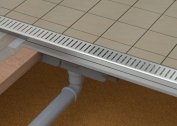For their convenience and comfort, people living permanently in a private house equip summer residences, country villas and cottages with all kinds of sewer devices. It can be an ordinary septic tank or an autonomous sewer station. For example, if this is a large family, then of course it is better to use the station. In the event that this is a cottage where guests appear from time to time, a septic tank is a good option, it is able to cope well with small volumes of effluents, but it requires additional maintenance. There are no problems and its installation will cost much cheaper than the station. It is impossible to determine and answer exactly which is better, each one decides for himself, according to his capabilities and needs.
It is necessary to think over and install a system for cleaning and discharging household waste at the initial stage of building a house.
Let's see which of the two is better to use.
The principle of operation of the septic tank
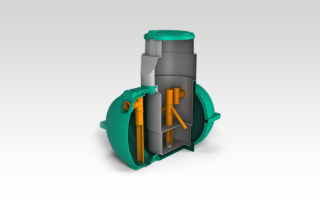 A septic tank is a moderate-sized tank in order to treat domestic wastewater discharged into it. It operates in several stages:
A septic tank is a moderate-sized tank in order to treat domestic wastewater discharged into it. It operates in several stages:
- collection of waste;
- sludge process;
- gravity-assisted filtration;
- withdrawal of purified water.
How the septic tank works
The device is divided into several compartments, in the form of waterproof cameras. When wastewater enters the first compartment of the septic tank, the hard particles of waste contained in them settle to the bottom by sediment. This is due to the fact that in their density they exceed the density of water. Having got rid of unnecessary garbage, the drains are clarified and by flowing into the neighboring compartment. Better cleaning followed by accumulating, replaceable filters. They rid the liquid of the smallest waste. Finally, the water is purified when it is withdrawn from the septic tank and falling into the ground, or a special well for sludge. Drinking such water is not recommended, it is considered technical. She can wash the car or use to water the garden.
It's important to know! When installing a particular septic tank, no matter which company, the volume of its tank must be calculated from the calculation of people living in the house who use drinking water. According to statistics, on average per day, a normal person consumes up to 200, 250 liters of water. Accordingly, if the family consists of four people, then the necessary volume of the receiving tank of the device should be no less than 800 liters.
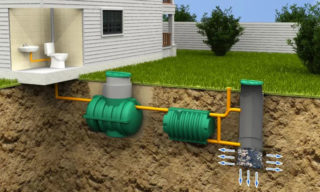 Some manufacturers add additional anaerobic filters to the septic tank. The entire septic tank is a huge, capacitive tank, in which, when cleaned with gravity, the water also goes through the disinfection path, by an anaerobic bacterium. This microorganism is able to exist in a confined space, absolutely without light and airless environment, in addition, accelerate the process of decomposition of waste.
Some manufacturers add additional anaerobic filters to the septic tank. The entire septic tank is a huge, capacitive tank, in which, when cleaned with gravity, the water also goes through the disinfection path, by an anaerobic bacterium. This microorganism is able to exist in a confined space, absolutely without light and airless environment, in addition, accelerate the process of decomposition of waste.
Septic tank with anaerobic bacterium
Regardless of the device of the septic tank, the number of its filters and the principle of operation, the final filtration of wastewater discharged to the outside is performed on the filtration field. This is a small piece of land on which a pillow of sand and gravel is designed. Liquid gets onto it from the drainage of the sewer and the soil is filtered out.
Attention! The distance between the drainage outlet in the filtration field and the water level is not less than 1 meter. Otherwise, it is necessary to build a well for sludge, or an earthen-sand embankment.
Advantages and disadvantages of the septic tank
As everyone is well aware, any unit has positive and negative characteristics of its work. The advantages of a septic tank are the following:
- Relatively low cost when compared with units and treatment plants.
- If desired, it is possible to construct personally, the main thing is to make a volumetric tank. To do this, you can use concrete rings, plastic barrels and even car tires.
- No need to connect to power.
- Simplicity and low cost of maintenance.
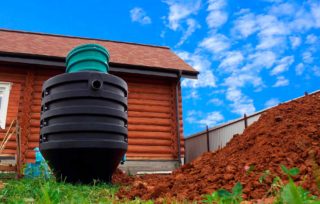 Unfortunately, the septic tank has many pluses, fewer than minuses. The following disadvantages of the device:
Unfortunately, the septic tank has many pluses, fewer than minuses. The following disadvantages of the device:
- For the installation of the tank, it is necessary to allocate a decent area of the land. The waste water tank has large dimensions, while the level of purification filters wants to be the best. In addition to all this, it is necessary to construct additional treatment facilities, in the form of fields for filtration or a well sump.
- According to the recommendation of experts, the waste water tank should be placed no closer than 5 meters from the residential building, but at the same time, not very far from it. Water flow is carried out by gravity. When installing long pipes they will quickly become clogged. In the case when the structure cannot be equipped with direct drains, the need arises to additionally place revision wells.
- During the construction of filtration fields, their removal to the source of drinking water should be no less than 20, 50 meters. It all depends on how water permeable the soil is.
- It is not recommended to arrange a garden with vegetables, herbs or fruits on the ground, which covers treatment fields.
- About once every 4, 6 years, there is an urgent need for periodic flushing of the drainage system, drainage and their replacement, depending on integrity and clogging.
- As the reservoir fills with sludge, the task arises of pumping it out.
Of course, many users of a septic tank use it only in the spring-autumn season, for the winter the system is canned. Unfortunately for this it is necessary by any means to pump out all the waste from the tank. Otherwise, they may silt it.
The principle of operation of stationary, autonomous sewage
Autonomy is a tank in which a full cycle of treatment takes place, discharged water with household waste. In the process of cleaning work, all decomposition actions take place inside the system. Therefore, neither in the soil, nor in the groundwater, pollution does not enter. The outlet water is clean, it can be used to irrigate the crop.
Autonomous sewage, design features
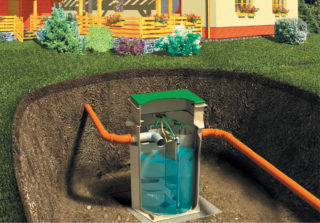 Structurally, the bioremediation station includes several watertight tanks. They are separated by special valves. When a sewage drain enters the station, it is mechanically cleaned over it in several tanks. Each of which is equipped with the same principle as in septic tanks, overflow. Initially, dense particles of debris settle on the bottom of the tank, in the form of sediment.
Structurally, the bioremediation station includes several watertight tanks. They are separated by special valves. When a sewage drain enters the station, it is mechanically cleaned over it in several tanks. Each of which is equipped with the same principle as in septic tanks, overflow. Initially, dense particles of debris settle on the bottom of the tank, in the form of sediment.
The next step is the flow of fluid into the adjacent compartment. It is inhabited and propagated by bacteria capable of decomposing waste waste into simple constituents, water, gas and mineral sediments. Due to the passage and purification by anaerobic filters, a small amount of water, in which microorganisms remain, flows back into the first compartment in order to process particles settled by sludge. While already processed, saturated with oxygen and pure water, is brought out.
Advantages and disadvantages of autonomous sewage
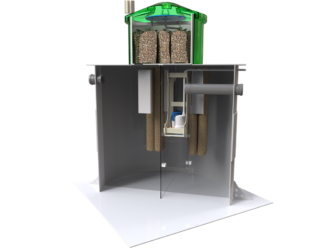 Unlike a septic tank, here anaerobic bacteria cannot live in a confined space without air. The advantages of a wastewater treatment plant are:
Unlike a septic tank, here anaerobic bacteria cannot live in a confined space without air. The advantages of a wastewater treatment plant are:
- The station is able to cope with a decent volume of wastewater, thanks to an integrated pump that speeds up the filtration.
- As well as a septic tank, each station is designed for a certain number of residents using water.
- The bioremediation system is compact enough, and there is no need to allocate a large area of land for it.
- Quick installation.
- There is no need to preserve for the winter or warm.
- It does not need to be serviced or resorted to the services of a scavenger.
Of course there are some minor flaws. Disadvantages of the biostation:
- It requires a power supply, without it pumps do not work. Wastewater will only be treated mechanically.
- Stations are used in homes where people live and use water. The biological bacteria living in it cannot develop without wastewater, they are their food. Their number will decrease, they die.
- Microorganisms inherent in the station do not tolerate all kinds of cleaning products and chemicals. They are killed by bleach. Accordingly, when cleaning plumbing devices, it will be necessary to exercise control over detergents.
- To prevent the filter from clogging your hair, it is necessary to install grids on the sink and shower drains.
- The design is not cheap.
What is better to choose
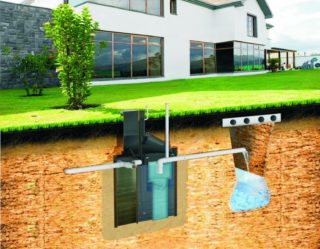 Until now, even experts cannot accurately determine and give an unambiguous answer, which is better: an autonomous biostation or a regular septic tank. There are several reasons and factors that affect the final decision of the user. To make a decision, we can summarize:
Until now, even experts cannot accurately determine and give an unambiguous answer, which is better: an autonomous biostation or a regular septic tank. There are several reasons and factors that affect the final decision of the user. To make a decision, we can summarize:
How much the system can serve:
- autonomous biostation, works up to 50 years;
- septic tank serves up to 20 years.
Waste recycling:
- An autonomous biostation is initially designed for a certain amount of effluents, for it there is no need for additional fields for treatment. The technical specifications describe how much is designed. For example, for a family of three people, a station is enough that can process up to 0.8-1.0 cubic meters of liquid;
- in order for the septic tank to process exactly the same volume, it is necessary to buy an additional pump. These are costs, which accordingly equates, according to the results of installation, to the cost of the station.
Unpleasant aroma:
- none of the septic tanks is leakproof, respectively, hydrogen sulfide is released and gives the installation site;
- an autonomous station does not have this drawback.
Water purification quality:
- any septic tank, even with the latest and most modern filters, is able to purify water by 75%;
- the biostation cleans up to 98%, and in the case when a UW filter is included, the cleaning is carried out at 100%.
System operation:
- septic tank works without electricity, seasonally;
- autonomous, even without electricity is able to work like a regular septic tank.
Service:
- a septic tank must be periodically cleaned and pumped out sludge, the use of additional, sophisticated equipment;
- station only rinse and clean out the sediment.
Location:
- the septic tank is installed in places with certain slope angles of the wastewater; take into account the remoteness to the house;
- an autonomous station is installed anywhere, even in problematic soils.
In the event that it is a residential building, more than 3 people live in it all year round, the water consumption is decent, it is necessary to install an automatic wastewater treatment plant. If this is a country house, residents are from time to time, the plot is spacious, and the soil is permeable, then in this case we select a septic tank. In any case, it is better to contact a professional who will help make the final decision.


